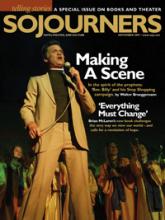“As we gather here, let us remember the lonely, for whom this company would be a festival of life; the persecuted, for whom this gathering would be an act of physical courage; and the hungry, for whom it would be the feast of a lifetime.”
My husband and I often use this table grace, and we use it whether or not young children are at the table. They aren’t alarmed—but then again, they aren’t starving, either.
How might young readers respond to a more direct encounter with disenfranchised individuals, even with children and teenagers caught in war? It’s possible to read viable, gripping, well-written, authentic accounts—autobiographical and fictional alike—about young people who lose their innocence and even childhood because they’re in the wake or epicenter of war, whether the war is an actual military venture or one of poverty. Even the venerable Dr. Seuss weighed in with The Butter Battle Book, a Cold War story about the escalating tit-for-tat violence between the Zooks and the Yooks.
Most literature created for children and teenagers involves a young protagonist, and often that main character tells the story. First-person narrators bring immediacy and credibility to the stories. Ishmael Beah, for example, shares graphic personal experiences in A Long Way Gone, a memoir about his youth in Sierra Leone as a boy soldier. He and other starving boys orphaned by war became crazed by drugs and dazed by the violence they had witnessed, and ultimately caused themselves, time and again. Originally published for adults, A Long Way Gone is also being read by teenagers; last summer it appeared on a few of the required summer reading lists for incoming college freshmen.
Read the Full Article
